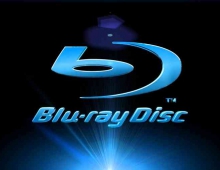
Blu-ray Disc Will Return Physical Business to Growth in 2010
Blu-ray Disc (BD) sales will not be sufficient this year to compensate for the widely reported downward trend in DVD sales, although industry analysts of Screen Digest expect global consumer spending on packaged video software to stabilise again in 2010.
As the DVD market continues to mature, ever-lower prices have combined with a global slowdown in unit sales, resulting in a fall of 2.8 per cent in consumer spending on buying and renting physical video formats in 2008. The global economic crisis, which slowed take-up of the hi-def format in most markets, means that 2009 is not expected to reverse this trend. However, Screen Digest expects BD to account for 8.5 per cent of total video spending globally this year, setting the scene for further expansion. Overall the company expects worldwide spending on video to show a slight dip in 2009 before stabilizing in 2010.
After years of decline, worldwide rental revenues bucked the trend and increased their share of worldwide spending on video software by half a percentage point in 2008 to 32 per cent. This growth was driven by an upturn in rental's share of spending in Japan and North America ? and happened despite the sector's continuing decline in Europe. The upturn in rental activity in the US was driven by strong growth in both online subscription rentals (dominated by Netflix) and rental kiosks (e.g. through Coinstar's Redbox-branded machines), as well as by the emergence of a BD rental business. Meanwhile the continuing importance of rental in Japan ? and the comparatively lacklustre performance of the sector elsewhere ? means that the country now accounts for 26 per cent of worldwide rental spending, up from 18 per cent a decade earlier.
With consumers in the world's two largest video markets continuing to spend on rental, Screen Digest expects the global rental sector to increase its share by another 2 percentage points in 2009, to 34 per cent of all video software spend. However, with rental's star now firmly in decline in Europe, this is unlikely to herald a more widespread resurgence in the sector.
A total of 2.7bn video software units were shipped to the global retail and rental sectors in 2008, down 1.4 per cent from the previous year. Whilst BD shipments saw a three-fold increase on 2007 to 67m units, they were unable to halt the overall decline in shipment numbers, a trend that has continued in 2009. Last year the DVD format represented 92 per cent of units shipped and the hi-def BD format just 2 per cent ? less than the 5 per cent accounted by the VCD format, which is found only in certain Asian markets. The international market continues to increase its margin on the North American market, accounting for almost 53 per cent of units shipped in 2008. Screen Digest expects the international business to increase its share of video shipments to 55 per cent in 2009.
The price of a DVD has been in decline since the format's introduction more than a decade ago; BD disc prices have dropped almost 10 per cent since its introduction (2006 in the US and Japan; 2007 elsewhere). The Asia Pacific region boasts both the most expensive DVD and BD retail discs (in Japan at an average of $38.53 and $54.16 respectively) and the cheapest DVDs (in China where the average legitimate DVD costs just $1.56). The cheapest BDs - averaging just $18.16 - are found in South Korea, where the US studios have recently scaled back their home entertainment presence in the face of rampant online piracy. Screen Digest expects the downward trend to continue, with the average worldwide price of a DVD forecast to drop 8 per cent to $13.42 in 2009.
Almost 499m households worldwide were equipped with at least one standalone DVD Video player or recorder by the end of 2008 - up 10 per cent on the previous year. Screen Digest expects the number of DVD households to increase 8.5 per cent to just over 540m in 2009, exceeding 500m for the first time. Just 5.8m households worldwide had a standalone BD player by the same point, although a further 23m had access to the BD format via Sony's PlayStation 3 (PS3) games console.
Screen Digest expects the number of dedicated BD players to reach 18.4m worldwide by the end of 2009, while more than 27m homes will have a PS3. Well over half of these machines will be found outside North America. David Scott, Senior Analyst, Asia-Pacific at Screen Digest, says, "The increasing availability of cheaper, entry-level BD players and expansion in the number of homes with an HDTV set will drive growth in BD player households in 2009, which in turn will boost sales of BD software."
Helen Davis Jayalath, Head of Video at Screen Digest says "Clearly, the start of a global recession was not the ideal time to launch an upgrade to what many consumers consider to be a perfectly serviceable home entertainment system and spending on the Blu-ray format has been slower than the industry had hoped as a result. However, Screen Digest's research shows that the hi-def BD format has the potential to return the physical video market to growth in 2010 and to ensure that packaged media can still compete in today's increasingly competitive entertainment world."
Taiwanese makers are also beleive that the global demand for Blu-ray Disc (BD) players and movie discs will steadily increase as average retail prices for players will drop from US$193 currently to US$77 in 2012 while blank media will drop from US$5 to US$1.50. Costs of BD pick-up heads and chipsets for Blu-ray disc drives are also expected to fall and thus production costs of PC-use BD optical disc drives will also drop.
According to figures released by the Blu-ray Disc Association in a BD Forum held yesterday in Taiwan, sales volumes of BD movie discs in the US, Europe and Japan during the first three quarters of 2009 increased 183%, 200% and 180% respectively from the same period in 2008.
After years of decline, worldwide rental revenues bucked the trend and increased their share of worldwide spending on video software by half a percentage point in 2008 to 32 per cent. This growth was driven by an upturn in rental's share of spending in Japan and North America ? and happened despite the sector's continuing decline in Europe. The upturn in rental activity in the US was driven by strong growth in both online subscription rentals (dominated by Netflix) and rental kiosks (e.g. through Coinstar's Redbox-branded machines), as well as by the emergence of a BD rental business. Meanwhile the continuing importance of rental in Japan ? and the comparatively lacklustre performance of the sector elsewhere ? means that the country now accounts for 26 per cent of worldwide rental spending, up from 18 per cent a decade earlier.
With consumers in the world's two largest video markets continuing to spend on rental, Screen Digest expects the global rental sector to increase its share by another 2 percentage points in 2009, to 34 per cent of all video software spend. However, with rental's star now firmly in decline in Europe, this is unlikely to herald a more widespread resurgence in the sector.
A total of 2.7bn video software units were shipped to the global retail and rental sectors in 2008, down 1.4 per cent from the previous year. Whilst BD shipments saw a three-fold increase on 2007 to 67m units, they were unable to halt the overall decline in shipment numbers, a trend that has continued in 2009. Last year the DVD format represented 92 per cent of units shipped and the hi-def BD format just 2 per cent ? less than the 5 per cent accounted by the VCD format, which is found only in certain Asian markets. The international market continues to increase its margin on the North American market, accounting for almost 53 per cent of units shipped in 2008. Screen Digest expects the international business to increase its share of video shipments to 55 per cent in 2009.
The price of a DVD has been in decline since the format's introduction more than a decade ago; BD disc prices have dropped almost 10 per cent since its introduction (2006 in the US and Japan; 2007 elsewhere). The Asia Pacific region boasts both the most expensive DVD and BD retail discs (in Japan at an average of $38.53 and $54.16 respectively) and the cheapest DVDs (in China where the average legitimate DVD costs just $1.56). The cheapest BDs - averaging just $18.16 - are found in South Korea, where the US studios have recently scaled back their home entertainment presence in the face of rampant online piracy. Screen Digest expects the downward trend to continue, with the average worldwide price of a DVD forecast to drop 8 per cent to $13.42 in 2009.
Almost 499m households worldwide were equipped with at least one standalone DVD Video player or recorder by the end of 2008 - up 10 per cent on the previous year. Screen Digest expects the number of DVD households to increase 8.5 per cent to just over 540m in 2009, exceeding 500m for the first time. Just 5.8m households worldwide had a standalone BD player by the same point, although a further 23m had access to the BD format via Sony's PlayStation 3 (PS3) games console.
Screen Digest expects the number of dedicated BD players to reach 18.4m worldwide by the end of 2009, while more than 27m homes will have a PS3. Well over half of these machines will be found outside North America. David Scott, Senior Analyst, Asia-Pacific at Screen Digest, says, "The increasing availability of cheaper, entry-level BD players and expansion in the number of homes with an HDTV set will drive growth in BD player households in 2009, which in turn will boost sales of BD software."
Helen Davis Jayalath, Head of Video at Screen Digest says "Clearly, the start of a global recession was not the ideal time to launch an upgrade to what many consumers consider to be a perfectly serviceable home entertainment system and spending on the Blu-ray format has been slower than the industry had hoped as a result. However, Screen Digest's research shows that the hi-def BD format has the potential to return the physical video market to growth in 2010 and to ensure that packaged media can still compete in today's increasingly competitive entertainment world."
Taiwanese makers are also beleive that the global demand for Blu-ray Disc (BD) players and movie discs will steadily increase as average retail prices for players will drop from US$193 currently to US$77 in 2012 while blank media will drop from US$5 to US$1.50. Costs of BD pick-up heads and chipsets for Blu-ray disc drives are also expected to fall and thus production costs of PC-use BD optical disc drives will also drop.
According to figures released by the Blu-ray Disc Association in a BD Forum held yesterday in Taiwan, sales volumes of BD movie discs in the US, Europe and Japan during the first three quarters of 2009 increased 183%, 200% and 180% respectively from the same period in 2008.





















